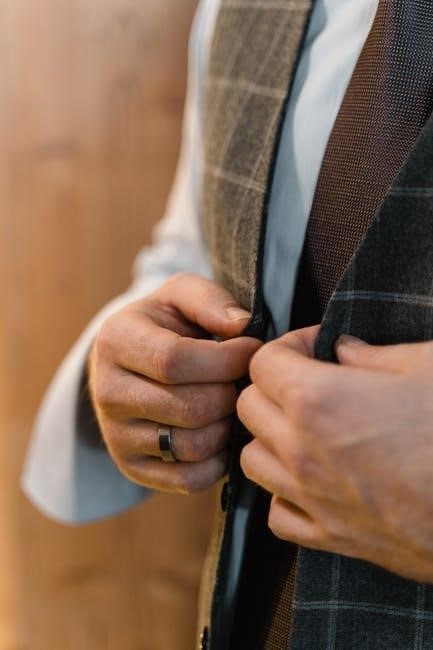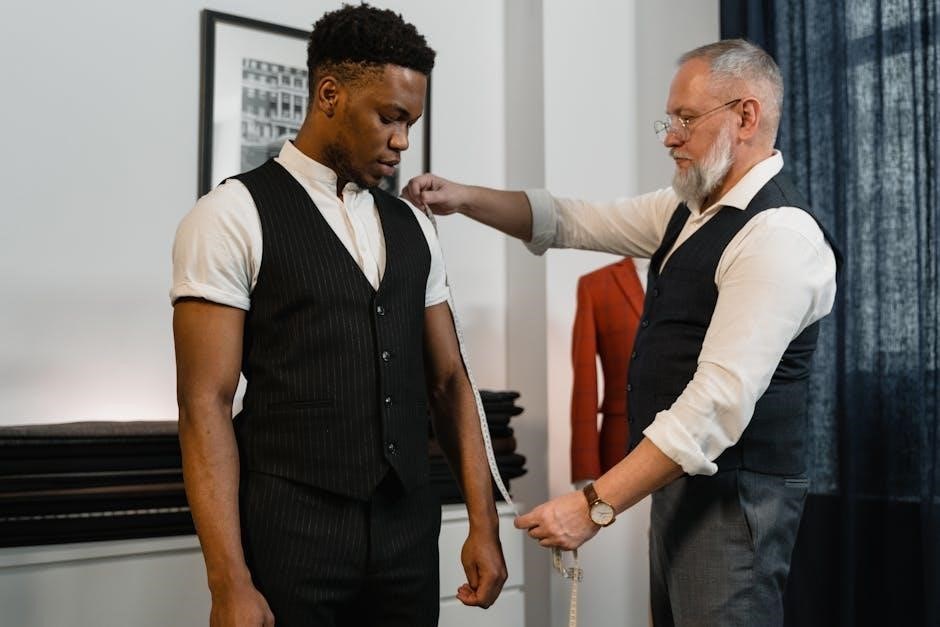A well-fitting suit jacket enhances confidence and style․ This guide provides essential measurements and tips to ensure a perfect fit, covering chest, shoulders, sleeves, and length․ Learn how to measure accurately for a tailored look․

How to Prepare for Taking Measurements
To prepare, stand tall, wear a fitted dress shirt, and ensure the tape measure is snug but not tight․ Use a mirror to verify accuracy for the best fit․
2․1․ Tools Needed for Measuring
To accurately measure for a suit jacket, you’ll need a flexible tailor’s tape measure, a pencil for marking points, and a mirror for visibility․ A well-fitting dress shirt and dress shoes are also essential․ The tape measure should be snug but not tight, ensuring comfort and accuracy․ Stand upright and relaxed to prevent skewed measurements; For precise shoulder and sleeve measurements, consider enlisting a helper․ If measuring alone, use a mirror to double-check alignment․ A calculator may be handy for converting or adjusting measurements later․ Ensure the surface for measuring is flat and smooth to avoid distortions․ Lastly, keep a notebook nearby to record each measurement clearly․ These tools will help you gather the necessary data for a perfect fit, ensuring your suit jacket looks and feels its best․
2․2․ What to Wear During Measurement
Wearing the right clothing during measurements ensures accuracy and a better fit for your suit jacket․ Start with a slim-fit dress shirt that mirrors the style you’ll wear with the jacket, as this provides a true chest measurement․ Avoid loose or bulky clothing, as it can distort your natural shape․ If you plan to wear the jacket with a specific type of shirt, wear one of similar thickness during measurements․ Shoes should also match those you’ll pair with the suit, as they affect posture and overall fit․ Keep jewelry and accessories minimal to avoid interference․ For the best results, wear nothing layers over your shirt, allowing the tape measure to lie flat against your body․ Ensuring these guidelines are followed will help you achieve precise measurements for a tailored fit․

Essential Measurements for a Suit Jacket
Accurate measurements are key to a perfect fit․ Essential measurements include chest size, shoulder width, sleeve length, jacket length, and body fit․ These ensure the jacket sits comfortably and looks tailored to your frame․

3․1․ Chest Measurement
The chest measurement is the most critical for determining your suit jacket size․ To measure accurately, wrap a flexible tape measure around the broadest part of your chest, typically just under the armpits․ Ensure the tape is snug but not too tight, as this can restrict movement and lead to an uncomfortable fit․ The measurement should be taken with your arms relaxed by your sides and your chest slightly expanded, as if taking a deep breath․ This ensures the jacket will accommodate your shirt and allow for a full range of motion․ If you’re unsure, it’s advisable to have someone assist you for precision․ Remember, the chest measurement directly impacts the fit across the shoulders and through the body, so accuracy is essential for a tailored look and comfort․ Proper alignment and posture during measurement are also crucial to avoid any discrepancies in the final fit․
3․2․ Shoulder Measurement
Measuring your shoulder width is essential for a well-fitting suit jacket․ To do this accurately, stand upright with your arms relaxed at your sides․ Place the tape measure across the back of your shoulders, starting from the tip of one shoulder and ending at the tip of the other․ Ensure the tape is level and snug, avoiding any sagging or tightness․ This measurement will help determine the jacket’s shoulder fit, ensuring it sits comfortably without being too tight or too loose․ Proper posture is key during this process, as slouching can lead to inaccurate results․ If you’re measuring yourself, consider enlisting assistance for precision․ The shoulder measurement is critical, as it directly affects the jacket’s overall fit and appearance․ A well-measured shoulder ensures the jacket drapes naturally, enhancing both style and comfort․ Accurate shoulder measurements are vital to avoid issues like restricted movement or an ill-fitting silhouette․
3․3․ Sleeve Length Measurement
To measure the sleeve length for your suit jacket, start by standing upright with your arms relaxed at your sides․ Bend your elbow slightly and place the tape measure at the back of your shoulder, just below the base of the neck․ The tape should run straight down the arm, following the natural curve, and end at the wrist bone․ Ensure the tape is snug but not too tight, as this will affect the fit․ For accuracy, wear a dress shirt during the measurement, as this will reflect how the jacket will fit over your clothing․ The average sleeve length for a medium-sized jacket is typically around 32-34 inches, but this can vary based on your height and build․ Proper sleeve length ensures the jacket cuffs will sit correctly, allowing about half an inch of shirt cuff to show․ Accurate measurements are crucial for a tailored fit, ensuring comfort and a polished appearance․ Measuring sleeve length correctly is essential for achieving the perfect balance between style and functionality in your suit jacket․

3․4․ Jacket Length Measurement
Measuring the jacket length is crucial for achieving the right proportions․ Start by standing straight and placing the tape measure at the base of the neck, just below the collarbone․ Gently extend the tape down the back, following the natural curve of the spine, and stop at the desired jacket length․ For most suits, the length typically ranges from the hip to about 1-2 inches below it, depending on personal preference and body type․ Ensure the tape is snug but not too tight, and consider wearing a dress shirt during measurement for accuracy․ Proper jacket length ensures the garment complements your torso, avoiding a boxy or overly long appearance․ The measurement should reflect your posture and body shape, providing a balanced fit that enhances your overall silhouette․ Accurate jacket length measurement is essential for a polished, tailored look․
3․5․ Body Fit and Shape Considerations
Ensuring the jacket fits your body shape is vital for a flattering appearance․ For slim builds, a tailored fit with slightly narrower shoulders creates balance, while muscular builds benefit from broader shoulders and extra chest room․ Larger builds look best in classic styles with a slightly looser fit to accommodate the torso comfortably․ The jacket should neither be too tight nor too loose, allowing freedom of movement while maintaining a streamlined look․ Posture plays a significant role in achieving the right fit, so stand upright during measurements․ Consider your natural stance and how the jacket aligns with your body․ The goal is to create harmony between the jacket and your physique, enhancing your overall silhouette․ By taking these factors into account, you can ensure a suit jacket that complements your unique body shape and delivers a polished, professional appearance․

How to Read a Suit Jacket Size Chart
Size charts combine numbers and letters to denote fit․ Chest size is key, with sleeve length and jacket proportions aligned to your measurements․ Use the chart to match your measurements for the best fit․
4․1․ Understanding Suit Jacket Size Denominations
Suit jacket sizes are typically denoted by a combination of numbers and letters, such as “42L” or “38S”․ The number represents the chest circumference, while the letter indicates the jacket length and fit․ Common designations include:
- S (Short): For shorter individuals, with shorter sleeves and jacket length․
- R (Regular): Standard fit, suitable for most body types․
- L (Long): Designed for taller individuals with longer arms and torso․
- XL (Extra Long): Combines larger chest measurements with extended length․
Understanding these denominations helps match your measurements to the correct size for a tailored fit․ Always refer to the specific brand’s sizing chart, as standards may vary slightly between manufacturers․
4․2․ Factors to Consider When Using a Size Chart
When using a suit jacket size chart, several factors can influence the accuracy of your fit․ First, consider your body type, as slimmer or broader builds may require adjustments to standard measurements․ Fabric thickness and texture can also impact how the jacket drapes, affecting the overall fit․ Posture plays a role, as slouching or standing straight can alter measurements․ Additionally, the size chart may not account for personal preferences, such as a tighter or looser fit․ It’s important to note that different brands often have slightly varying standards, so measurements may differ between manufacturers․ Always cross-reference your measurements with the specific brand’s sizing guidelines․ If possible, try on jackets before purchasing, or consult a tailor for custom adjustments․ These considerations ensure a more precise fit, making the size chart a useful but not absolute guide․
Tips for Ensuring the Best Fit
Stand tall during measurements to ensure accuracy․ Consider fabric thickness, as it affects drape and comfort․ Personal style preferences, like slim or loose fits, should guide your choices․ A tailor can refine adjustments for perfection․
5․1․ Importance of Posture During Measurement
Maintaining proper posture during measurements is crucial for achieving an accurate fit․ Stand up straight with shoulders relaxed and feet slightly apart․ Slouching can lead to incorrect measurements, particularly around the chest and shoulders․ When measuring, ensure the tape is snug but not tight, and keep the shirt smooth․ Poor posture can result in a jacket that feels restrictive or ill-fitting․ By staying upright, you ensure that the measurements reflect your true proportions․ This is especially important for the chest and sleeve length, as any deviation can affect the overall comfort and appearance of the jacket․ Remember, accurate posture ensures a tailored fit that complements your physique and enhances your confidence․
5․2․ How Fabric Choice Affects Fit
Fabric choice plays a significant role in determining the fit of a suit jacket․ Different materials drape differently, and this can impact how measurements are interpreted․ For example, stretch fabrics like wool or cotton blends offer flexibility, allowing for a slightly tighter fit without discomfort․ On the other hand, heavier fabrics such as tweed or linen may require a bit more room to ensure mobility and comfort․ The thickness of the fabric can also influence sleeve and shoulder measurements, as bulkier materials may need additional space to lie smoothly․ When selecting a fabric, consider both the occasion and your personal comfort level․ A well-chosen fabric ensures the jacket not only fits perfectly but also maintains its shape and appearance over time․ Ultimately, the interplay between fabric and fit is crucial for achieving a polished, tailored look․

Measuring for Different Body Types
Measuring for different body types requires considering individual proportions and body shape․ Whether slim, muscular, or larger builds, accurate measurements ensure a tailored fit․ Proper techniques cater to each physique effectively․
6․1; Slim Build Considerations
For individuals with a slim build, achieving a well-fitting suit jacket requires precise measurements to avoid a boxy or oversized appearance․ The chest measurement should be taken snugly around the broadest part of the chest, ensuring the tape measure is level and not too tight․ This ensures the jacket fits comfortably without restricting movement․ Shoulder measurements are critical for slim builds, as overpadding can create an unbalanced look․ The jacket’s shoulder width should align closely with the natural shoulder line to maintain a streamlined silhouette․ Sleeve length should be measured from the center back of the neck to the wrist, ensuring the sleeves are proportional to the arm length․ Jacket length should hit just below the hip to elongate the torso without overwhelming the frame․ Proper posture during measurement is essential to ensure accuracy․ For slim builds, opting for a fitted or tailored style is recommended to enhance the physique․ Additionally, lightweight fabrics can create a more flattering drape, preventing the jacket from appearing bulky․ By focusing on these key measurements, a slim build can achieve a sharp, tailored look that complements their body type․ Attention to detail ensures the suit jacket flatters rather than overwhelms the wearer․
6․2․ Muscular Build Considerations
For individuals with a muscular build, achieving a well-fitting suit jacket requires careful measurements to accommodate broader shoulders and a larger chest․ The chest measurement should be taken snugly around the broadest part of the chest, ensuring the tape measure is level and not too tight․ This ensures the jacket fits comfortably without restricting movement․ Shoulder measurements are particularly important, as muscular builds often have broader shoulders․ The jacket’s shoulder width should align closely with the natural shoulder line to avoid a boxy or ill-fitting appearance․ Sleeve length should be measured from the center back of the neck to the wrist, ensuring the sleeves are proportional to the arm length․ Jacket length should hit just below the hip to balance the proportions of the body․ Proper posture during measurement is essential to ensure accuracy․ For muscular builds, a slightly longer jacket length can help create a balanced silhouette․ Additionally, choosing a fabric with stretch or structure can accommodate muscle mass while maintaining a sharp, tailored look․ By focusing on these key measurements, a muscular build can achieve a powerful yet refined appearance in a suit jacket․ Attention to detail ensures the jacket complements the wearer’s physique without sacrificing comfort or style․
6․3․ Larger Build Considerations
For individuals with a larger build, achieving a comfortable and flattering fit in a suit jacket requires careful attention to measurements․ The chest measurement is particularly important, as it should accommodate the broadest part of the chest without being too tight or restrictive․ The tape measure should be snug but not compressing, ensuring the jacket allows for ease of movement․ Shoulder measurements should align with the natural shoulder line to avoid a boxy appearance, while sleeve length should be proportional to the arm length, ensuring the cuffs hit just above the wrist․ Jacket length should be slightly longer to balance the proportions of the body, typically hitting just below the hip․ Proper posture during measurement is crucial to ensure accuracy․ For larger builds, opting for a jacket with a bit more structure or stretch in the fabric can provide comfort and support while maintaining a sharp, tailored look․ Additionally, considering the fit of the trousers and ensuring the overall silhouette is balanced can enhance the appearance of the suit․ By focusing on these key considerations, individuals with a larger build can achieve a confident and polished look in their suit jacket․